No matter how it's done, reproduction is weird, often wonderful and sometimes scary. Back in 2000, Bill Joy, chief scientist at Sun Microsystems, wrote an article in Wired magazine titled "Why the Future Doesn't Need Us." In it, he predicted that a catastrophic development was just around the corner: self-replicating robots. Once that eventuality had been reached, he feared, human life as we know it would shortly become irrelevant.
且不论动物们是怎么做到的,它们繁衍后代的方式的确是千奇百怪。多数奇妙有趣,有些却让人毛骨悚然。遥想2000年时,太阳计算机系统公司的首席科学家比尔·乔伊曾在《连线》杂志上发表了一篇题为《未来不需要我们》的文章,他预言自我复制机器人的产生这一灾难性变革近在眼前;他担心自我复制机器人面世之时,就是人类消亡之日。
But you don't have to look to the future for examples of strange reproductive possibilities. In ancient Greece, Zeus, god of thunder and head honcho on Olympus, had a memorable encounter with childbirth. One day Zeus had a liaison with one Metis, goddess of craftiness. Too late, he remembered a prophecy that predicted Metis's children would be more powerful than their father. Worried about the consequences, he quickly swallowed his lover whole. Of course, it was too late — she was already pregnant. Sometime later, having developed a phenomenal headache, he got one of his fellow gods to chop his skull open with an axe. Out jumped his new daughter, Athena, goddess of wisdom, in full battle gear. All this might sound improbable, but it's no stranger than some of the bizarre ways organisms are self-replicating in real life, right now.
但若只是想找寻一些奇葩的繁衍方式,大可不必翘首未来,从过去的故事中即可窥知一二。传说在古希腊,司掌雷电的奥林匹斯山主神宙斯,有过一次难忘的分娩经历。某日宙斯临幸了慧聪女神墨提斯,事后他才忆起盖亚和乌拉诺斯的预言——墨提斯将生下比自己更强的孩子。他心生惧怕,于是把墨提斯整个吞进了肚子。可惜为时已晚,墨提斯此时已经怀孕。不久,宙斯头痛难忍,便命令手下的神用斧头劈开他的头颅,他的女儿——全身武装的智慧女神雅典娜便跳了出来。这一切听起来简直像是无稽之谈,即便如此,这也绝不会比现实生活中有些生物自我繁殖的方式更加奇怪。那接下来就让我们一起来看看吧。
10.孤雌生殖的蜥蜴
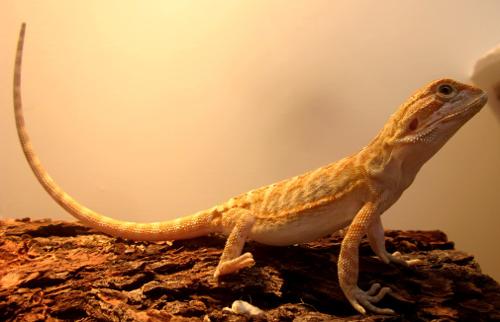
Maybe it's because the reproductive process is so strange that humans have been telling stories about virgin births since storytelling began. The most famous of these tales is, of course, the one about the birth of Jesus Christ whose mother, Mary, is said to have conceived while still a virgin.
或许正是因为繁衍后代如此神奇,“处女生育”的故事才会层出不穷,流传至今。其中最出名的莫过于耶稣的降生,传说他的母亲——圣母玛丽亚怀孕时就是处女。
While it's technically possible for a woman to produce a virgin birth, it's incredibly unlikely. On the other hand, parthenogenesis (the scientific term for virgin birth) is common among other creatures in nature. Hammerhead sharks, komodo dragons, mole salamanders, and an assortment of other reptiles, fish and insects can all produce offspring without mating. It all starts with something called a "germ cell." This germ cell splits in two, and then each of those halves splits again. Now you've got four reproductive cells, called gametes. Three gametes are discarded. The remaining gamete contains half the chromosomes necessary to create a new individual. In sexual reproduction, a female gamete and a male gamete fuse, creating a complete set of chromosomes. But in parthenogenesis, the female gamete, or egg, contains a complete set of chromosomes and is able to stimulate itself to grow. Incredibly, there are species of insects that go back and forth between parthenogenesis and sexual reproduction, depending on which method works best for the environment they're in at the time (e.g., is there a mate available?). Then there's something called cyclic parthenogenesis in which organisms such as water fleas alternate back and forth between mating and non-mating reproduction. As yet, nobody's found any examples of parthenogenesis in mammals, but it's been artificially induced in rabbits, among other critters, with the help of temperature control and chemicals. No luck with humans so far...
尽管处女生育在技术上可行,但人们还是很难相信这个事实。不过在自然界,生物体的孤雌生殖(处女生育的学名)十分普遍,锤头鲨、科莫多巨蜥、摩尔蝾螈和其他种类的爬行动物、鱼类以及昆虫都可以不经交配,直接繁殖。这一切的过程都始于“生殖细胞”。这种细胞可以一分二,然后二分四。我们把得到的这四个生殖细胞叫做“配子”,其中的三个将被弃置,剩下一个则包含创造新生命所需的一半染色体。在有性生殖中,一个雌配子和一个雄配子结合,就可以合成一套完整的染色体组。但在孤雌生殖中,一个雌配子,或称为一颗卵子,即包含整套生物体所需的染色体,并能刺激自身生长,最终成为新的个体。令人难以置信的是,不少昆虫能够从容游走于孤雌生殖和有性生殖之间,选择哪种繁殖方式完全取决于当时的环境(例如是否能找到异性交配)。此外,还有一些生物遵循所谓的“周期性孤雌生殖”规律,例如水蚤就是交替进行孤雌生殖和有性生殖的。截至目前,自然界中尚未发现任何哺乳动物进行孤雌生殖的例子。但是通过温度控制和化学控制,已经成功实现人工诱导兔子以及其他小动物进行孤雌繁殖。但人类至今无缘于此。
9.雄雌变换的尼莫鱼
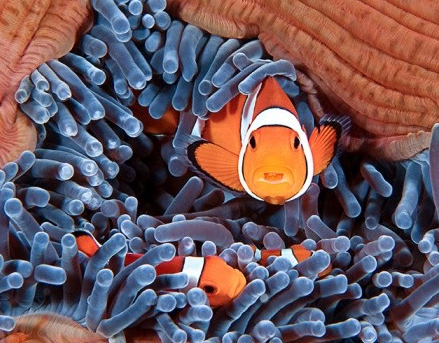
Let's not confuse parthenogenesis with hermaphroditic reproduction! They're not the same at all. In parthenogenesis, the female gamete does all the work single-handedly. Hermaphrodites, however, are remarkable for being able to produce both male and female gametes. That's because they have both male and female reproductive organs.
别把雌雄同体和孤雌生殖搞混了!这是两个完全不同的概念。孤雌生殖是指雌配子能独自完成所有生殖工作,而雌雄同体的奥妙则在于生物体同时拥有雄性生殖器官和雌性生殖器官,可以同时产生雌配子和雄配子。
In some species, like certain flowers, snails and fish, hermaphroditism is common. Sometimes an organism might start off male and turn female; sometimes they might start off female and turn male; and sometimes they remain both sexes throughout their lifespan. Remember Nemo and his dad in "Finding Nemo"? It turns out a sequel is warranted because there's a lot of drama in the reproductive lives of clownfish. Socially, clownfish like to hang out in sea anemones where two large breeders, a male and a female, are in charge of a group of smaller male clownfish who don't reproduce. But say, for instance, the female breeder dies. In that case, the large male switches its sex to become the dominant female while the biggest of the small males quickly bulks up to take on the role of sexually mature male breeder. Come on Pixar — "Becoming Nema" is a hit waiting to happen.
有些物种的雌雄同体现象十分普遍,比如某些品种的花、蜗牛和鱼类。它们中有些生而为雄,却可在日后变为雌性;也有些生而为雌,却可在后天转为雄性。有些物种终其一生,都会同时具备双性特征。还记得《海底总动员》里的尼莫和他的父亲吗?这部电影出个续集还是很有必要的,你都不知道小丑鱼的繁殖是多么的有趣!一般而言,小丑鱼喜爱成群结队穿梭于海葵之间,除了领头的一对成年雄性和雌性小丑鱼负责生育外,其余均为不能生育的年幼雄鱼。但比如说,领队的雌鱼去世了,那么领队的雄鱼就会变性,成为领队的雌性,同时,这群年幼的雄鱼里最强壮的那条就会迅速成长、成熟,成为领队雄性,担当生育大任。皮克斯!快放大招把!我们都等不及想看续集里尼莫的父亲突然变成母亲了,那一定是个大卖点!
8.偷盗卵子的雄蛙
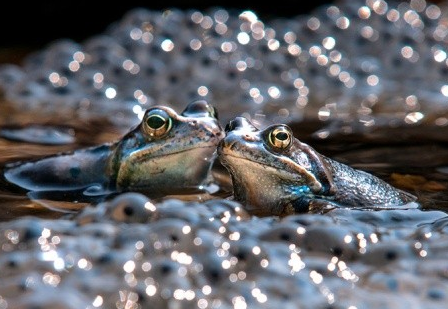
Clutch piracy is a breeding strategy that involves frogs sporting eye patches and wielding cutlasses while swigging rum.
窃卵是一种繁殖策略,但乍一听还以为是青蛙蒙上运动眼罩,痛饮朗姆酒后手拿刺刀变身江洋大盗去偷盗卵子。
Actually, no it's not. It does involve frogs, but they're naked and they live in the Pyrenees, not Barbados. Their lack of clothes is important — high in the Pyrenees, the nights are so chilly that frogs, who typically like to mate under the cover of darkness, are forced to get busy on sunny afternoons instead. Thanks to this local peculiarity, researchers were able to keep a close eye on the process and observed a weird deviation from the usual ho-hum external fertilization they expected to see. External fertilization is the preferred reproductive strategy of many fish and amphibians. The female lays a "clutch" of eggs in the water and then a male deposits some sperm on them. Frogs like to make sure this process is accomplished without delay. Typically when a female frog is ready to lay her eggs, she lets a male climb on her back and give her a big bear hug. She releases her egg clutch, and the male immediately fertilizes it. However, his sperm might fertilize only a percentage of the eggs in the clutch. High in the ponds of the Pyrenees, frog romance works a little differently. Male frogs vastly outnumber the females. Because they often can't find a female to mate with, gangs of piratical males have taken to hunting for freshly laid egg clutches. As soon as they find them, they do their best to fertilize any of the unfertilized eggs that are left. Researchers have found clutches with as many as four different fathers!
事实上并非如此。这确实与蛙类有关,但它们一种是生活在比利牛斯山脉而非巴巴多斯山脉,且皮肤裸露的蛙类。他们“衣不蔽体”这一特点至关重要——因为在高高的比利牛斯山上,长夜如此寒凉,这些本喜好在夜幕笼罩下“造人”的蛙类,不得不将此事安排在阳光灿烂的午后。多亏了此地得天独厚的地理条件,研究者们才能密切观察这一蛙类的受精过程,从而发现了这与他们平日里早已司空见惯的体外受精方式并不相同。体外受精是鱼类和两栖动物首选的繁殖方式。雌性动物在水中产下一“窝”卵,接着雄性动物再将精子排在卵子上。青蛙们想要确保此过程不被延误,因此当雌蛙准备产卵时,就会让雄蛙爬到她的背上,给她一个大大的熊抱。雌蛙排完卵后雄蛙立刻使其受精。然而,这样的受精率可能只有1%左右。在高高的比利牛斯山上的池塘里,青蛙们的浪漫情事却有所不同。这里雄蛙的数目远超过雌蛙,所以经常找不到配偶,这就迫使雄蛙海盗团伙不得不到处寻找新产下的卵。一旦找到卵堆,他们就会竭尽全力给其中的未受精卵受精。研究者们曾发现一个卵堆中的受精卵竟有4个父亲!
7.“勾引”蜜蜂的蜂兰花
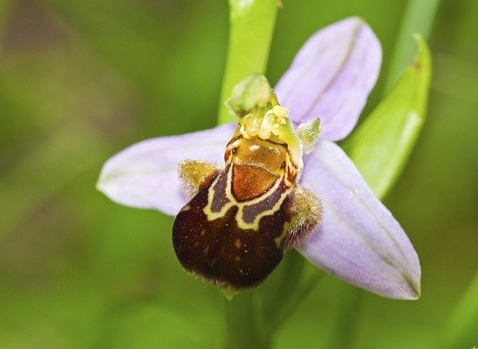
Most flowers have an I-pat-your-back-you-pat-mine relationship with the pollinators that help them reproduce. Bees, butterflies and hummingbirds, for instance, get a delicious sip of nectar in return for carrying some grains of pollen from one flower to the next. Once this happens, the receiving flower can start the process of making the seeds that will grow into new flowers.
大多数花儿和帮助它们繁殖的传粉者之间都保持着互帮互助的关系。例如蜜蜂、蝴蝶、蜂鸟等动物,都会在为花儿传粉的同时吮吸一口甜美的花蜜作为回报。此后,受粉的花朵就能逐渐结出种子,这些种子最终又能长成新植株。
But certain species of orchids find this strategy old hat, not to say downright boring. With pollinators hopping from one flower to its neighbor, orchids worry about inbreeding. Well, as far as we know, they don't actually worry, but evolution has resulted in a far more novel — in fact truly bizarre — method of self-replicating for these organisms. In mountainous regions of the Mediterranean, there's a species called Ophrys apifera, better known as the bee orchid. In an incredible trompe l'oeil effect, the flower looks precisely like the rear of a female bee with its head buried in a blue-petalled flower. Not only that, Ophrys mimics the scent of said female bee, and it's even a little furry to add to the sensory illusion. This deception is so perfect that even its seeming imperfections turn out to be advantageous. Male bees, seduced by the floral wizardry, fall to mating so vigorously with the flowers that they dislodge pollen packs pre-loaded with a special adhesive that sticks to their backs. But according to plan, the deception only lasts so long. After some frantic efforts at achieving erotic bliss, the bee wises up to the fact that he's been had and staggers away in a fit of frustration. He'll wander a fair distance collecting his wits before he falls for the trick again and, if all goes well for perfidious Ophrys, unwittingly deposits his pollen payload in another bee orchid flower. The bee's frustration plays into the orchid's reproductive strategy, as the distance traveled while the bee was cooling his temper prevents inbreeding. Of course, bees aren't the only ones seduced by orchid magic — think of all the orchid plants flowering on windowsills the world over.
这种繁殖方式虽说不上无聊透顶,但某些品种的兰花却嫌弃它过于老套。传粉者们在临近的花朵间不停地忙碌着,但兰花们却担心近亲交配的发生。尽管我们知道他们并不会真的为此担心,但生物进化已然催生了更为新颖(实际上超级怪异)的自我繁殖方式,以适应这些生物的需求。在地中海沿岸的山区,有一种植物叫蜂兰花,而人们更喜欢叫它蜜蜂花。在视觉陷阱的效应下,这种花看起来真的很像把头埋入蓝色花瓣中,只留背部在外的雌蜂。此外,蜂兰花还能释放与雌蜂类似的气味,甚至还长有绒毛,使其看起来毛茸茸的,更加深了这种感官错觉。这种骗术如此完美,甚至使它那外观上的缺陷都转变成了优点。被蜂兰花的幻术吸引而来的雄蜂争先恐后地与花朵交配,预先带有特殊粘性的花粉便会粘在雄蜂背上。但是按照原计划,骗术只能维持这么久。雄峰在为了满足性欲对蜂兰花实施了残暴的摧残后,才意识到自己上当了,于是带着失落,步履蹒跚地离开。雄蜂会飞行很长的一段距离来“疗伤”,直到下次掉入陷阱。对始作俑者蜂兰花来说,如果一切顺利,雄蜂负载的花粉就能不知不觉地落在另一朵花上。于蜂兰花而言,雄峰的失落正中下怀,因为雄蜂在冷静的过程中飞得越远,就越能防止蜂兰花的近亲交配。当然,想想看那开在窗台上千姿百态的兰科植物,全世界有那么多种类的兰花,蜜蜂并不是唯一一种被它们的魔法吸引的动物。
6.多种性别的四膜虫
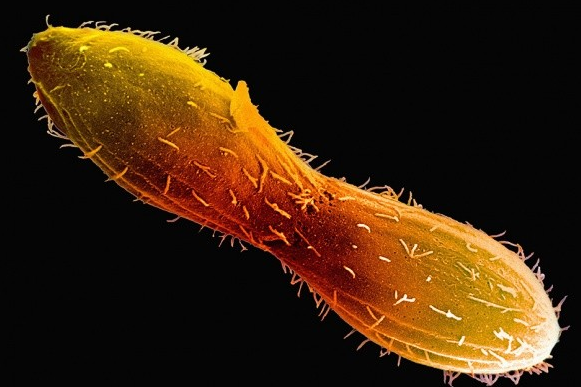
Next time you cool off in a lake, try not to think about the fact that you might be surrounded by furry single-celled microbes engaging in some truly peculiar reproductive behavior. Actually, for the most part, Tetrahymena is quite a chaste creature that uses the virginal method of parthenogenesis to populate its fresh-water environs.
下次你在湖边乘凉时,请尽量忘记以下事实——n多毛茸茸的单细胞微生物正在你周围进行一些非常奇异的繁殖活动。事实上,多数情况下四膜虫是一种非常纯洁的生物,它们采用贞洁的孤雌生殖方式在其生存的淡水中产下自己的后代。
But parthenogenesis doesn't create the kind of genetic variation that can help organisms adapt to changing surroundings. So when times are tough, Tetrahymena can actually switch on a dormant sex drive to help it survive. That's when things get very interesting. If you think keeping track of gender politics is complicated, consider the fact that this little creature has no fewer than seven genders! Scientists have imaginatively termed these genders Types I through VII. A Type I can't mate with another Type I, but not to worry — it can choose from among any one of the remaining six genders. The new baby Tetrahymena get all the genetic info necessary to become any one of the seven possible types. Then, through a random process, their DNA gets pruned down to a single gender. Pretty complicated stuff for a microscopic microbe!
但是孤雌生殖不能产生遗传变异,而遗传变异有助于生物体适应环境变化。因此,当周边环境变得不适宜生存时,四膜虫会启动一直休眠的性欲,以帮助自己存活。那时,事情就变得非常有趣了。如果你觉得研究性别政治已经非常复杂了,那就想想吧,这个小小的微生物竟然有不少于7种的性别!富有想象力的科学家们将这7种性别称为类型1至类型7。两个个性别都为类型1的四膜虫无法交配,但是别担心,它可以与另外6种性别中任一种交配。新形成的四膜虫携带了父代全部的基因,因而它们也能转变为7种性别中的任一种。然后,经过随机选择,它们的DNA组将被修剪,最终只保留一种性别。对极其微小的微生物而言,这真真是一件相当复杂的事。

















